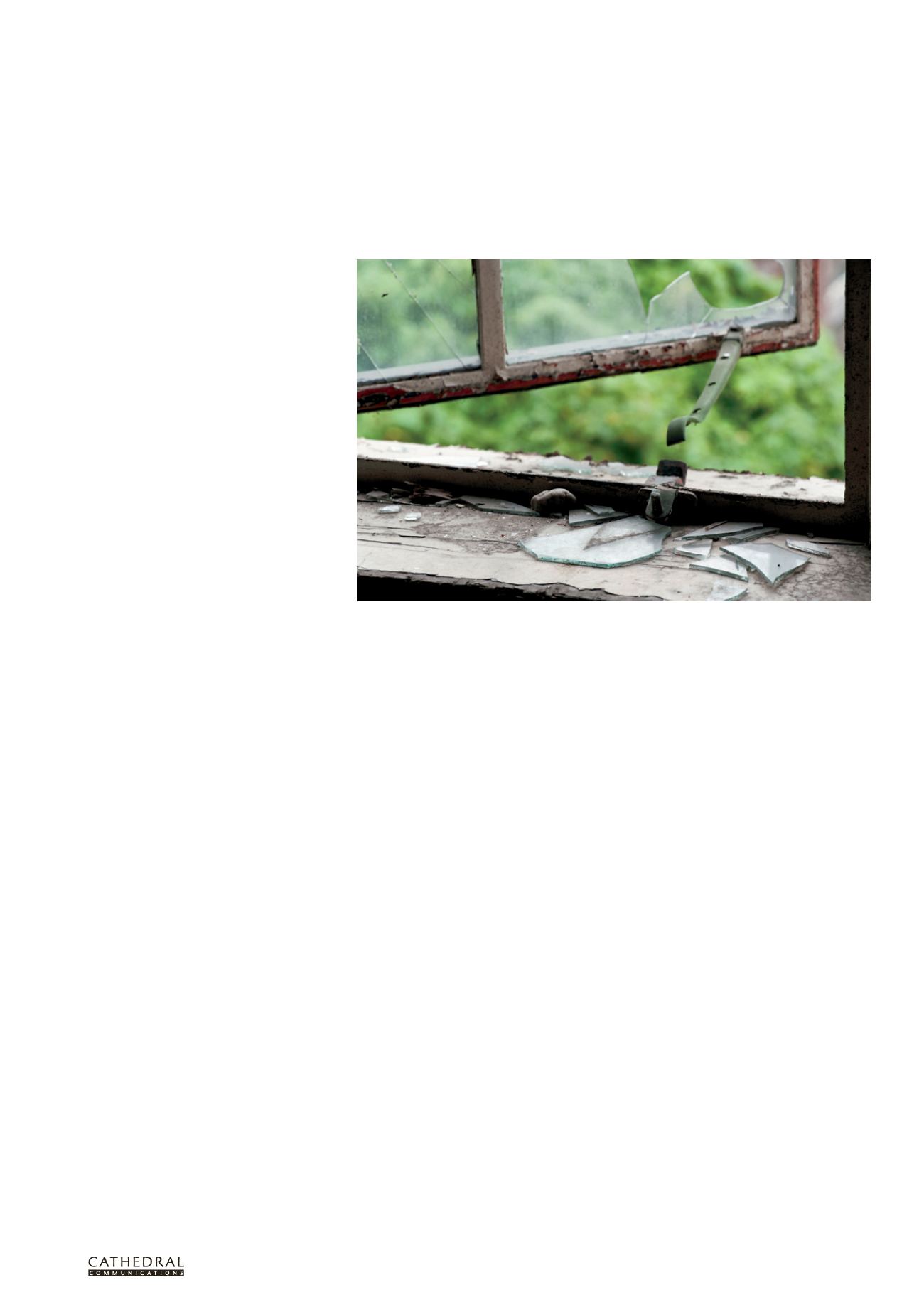
T W E N T Y F I R S T E D I T I O N
T H E B U I L D I N G C O N S E R VAT I O N D I R E C T O R Y 2 0 1 4
5 9
2
BUILDING CONTRACTORS
CRIMINAL DAMAGE
JONATHAN TAYLOR
I
N 2011
a survey commissioned by English
Heritage found that 19 per cent of all listed
buildings in England were affected by
criminal damage in that year alone (see www.
english-heritage.org.uk/heritagecrime). The
‘heritage crimes’ recorded ranged from graffiti
and unauthorised alterations to the theft of
metal roof coverings and arson, and in almost
half the cases the damage was substantial.
Although the study was limited to
England, criminal damage to historic
buildings is common throughout the UK.
Most at risk are buildings which are known
to be unoccupied at night, such as churches
and building sites where historic buildings are
vacated and scaffolded, and the biggest single
threat is metal theft.
CAUSE AND EFFECT
Damage to historic buildings is often
incidental and a consequence of ignorance.
Damage by owners and developers acting
without listed building consent is usually made
in ignorance of the law or of the importance
of having specialist advice – or both. In some
cases it is simply that the owner or the building
contractor is unaware that every element of a
listed building is protected by law, and that it
is a criminal offence to carry out most work
without listed building consent. In other cases
the owner or contractor may consider that
the works are relatively minor, and that listed
building consent is simply unnecessary red
tape which will serve only to delay work.
Most owners and contractors do not set
out to intentionally harm the building they are
responsible for, but without the scrutiny of the
conservation officer mistakes happen.
Ignorance of the consequences also
contributes to the harm caused through
graffiti and some acts of vandalism, as
outlined by Lucy Branch on page 93. Historic
buildings and monuments are a finite
resource, and over time the cumulative impact
of repeated cleaning, repair, damage and loss
can be devastating.
High rates of theft, graffiti and arson
are often prevalent in specific urban areas,
reflecting a wider context of social problems.
The visible impact on the environment can
discourage investment in the buildings
of that area, compounding the problem.
Without prompt action by key stakeholders
and the local authority, historic buildings and
residents can be caught in a vicious cycle of
urban decline.
The high price paid for some recycled
materials and architectural salvage has
encouraged thefts from historic buildings.
In recent years lead roofs have been the
most common targets for thieves, fuelled
by soaring demand for scrap metal, but
other items are often stolen too, including
decorative features such as fireplaces
and sculptures. Even clay tiles have been
stripped from the roofs of remote farm
buildings, and scaffolds can provide easy
access to a wide variety of equipment and
materials in unoccupied buildings.
According to the research commissioned
by English Heritage, one in seven religious
buildings had been affected by lead theft. Not
only roofs are affected, but also gutters and
downpipes. Whether the material is plain and
modern or hundreds of years old and of great
architectural and historic interest, it all ends
up in the melting pot. When hidden flashings
and parapet gutters are stolen, often the first
sign of the theft is a leaking roof following a
storm, and the consequent water ingress adds
to the damage already caused.
All burglaries from historic buildings
contribute damage to historic fabric, and in
the most appalling cases, burglars have been
known to set fire to the building in order to
hide evidence.
Fabric and components introduced to
replace those which have been damaged or
lost are of course new, not historic. Repairs
and replacements will help to secure the
integrity of the building or monument, and
may be beautiful in their own right, but the
connection with the past is diminished.
PREVENTION
All historic buildings should have a risk
assessment carried out to identify which
elements are most likely to be the targets of
vandalism or theft, when they are most at risk,
and how access is likely to be gained. In most
cases this is not complex and may be carried
out by either the owner or the professional
with the advice of the police, but in the more
complex and most important cases it may be
necessary to bring in a security consultant
with specialist expertise. Specific risk
assessments should also be carried out when
major works are undertaken or the building is
to be vacated for a long period.
Key areas to be considered include:
Perimeter protection
– ideally, it should be
possible to exclude all vehicular access when
necessary, to prevent the removal of large
objects: notices at the principal access points
can also help to deter intruders by advising
them of the deterrence measures in place
(such as the security marking systems used),
and by asking visitors to report any suspicious
activity to the police
Surveillance
– intruders and others
should feel watched in all areas immediately
around the building: consider security lighting
(which need not be ugly) and visible indicators
of surveillance such as cameras, and lights
inside the building
Access to tool stores
etc – implements
which might be useful to a burglar, arsonist or
other miscreant must be well secured
Building envelope protection
– all likely
access points should be identified, secured
and, where possible, alarmed, including doors,
windows and their related access routes such
as walls, drainpipes and roofs (anti-climb
paint may be used above two metres with
appropriate warning notices)
(Photo ©iStock.com/zmeel)


